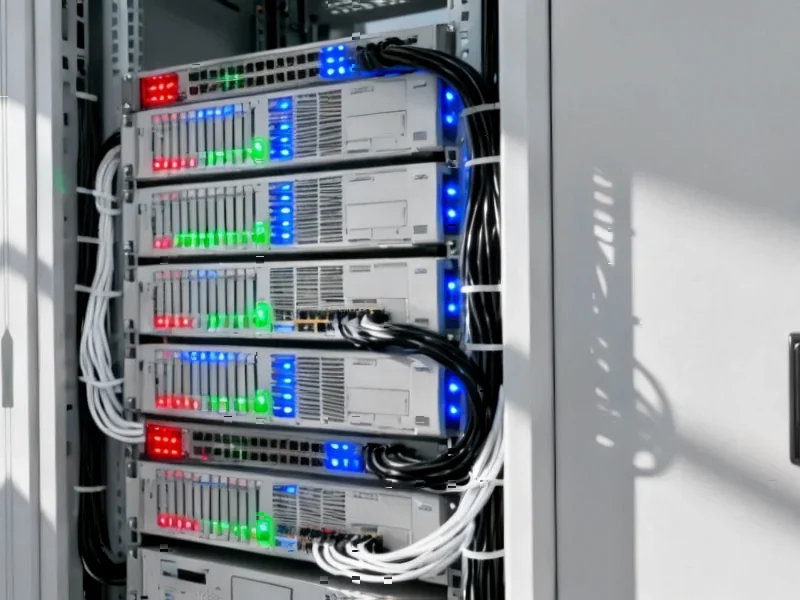According to Windows Report | Error-free Tech Life, Microsoft has signed a massive $9.7 billion, five-year agreement with data center operator IREN to access NVIDIA’s cutting-edge GB300 AI chips. The deal gives Microsoft access to nearly 3,000 megawatts of total capacity across IREN’s North American data centers, with deployment scheduled in phases through 2026 starting at IREN’s 750-megawatt Childress, Texas campus. Microsoft’s prepayment will help finance IREN’s separate $5.8 billion deal with Dell, and the tech giant also confirmed a multibillion-dollar agreement with AI cloud startup Lambda for similar NVIDIA-backed infrastructure. This follows Microsoft’s recent $17.4 billion deal with Nebius Group, showing the intense competition for AI computing capacity. This strategic shift toward infrastructure partnerships marks a fundamental change in how tech giants approach AI scaling.
The Rise of AI Infrastructure as a Service
What we’re witnessing is the emergence of AI Infrastructure as a Service as a distinct business model. Rather than following the traditional cloud computing playbook where hyperscalers build everything themselves, Microsoft is essentially outsourcing its AI capacity expansion to specialized operators. This represents a maturation of the AI infrastructure market where companies like IREN, Lambda, and Nebius Group can offer turnkey solutions that would take Microsoft years to develop independently. The scale of these partnerships suggests we’re entering an era where even the largest tech companies recognize they can’t build fast enough to meet AI demand alone.
The Hidden Power Constraint Driving These Deals
Behind these massive dollar figures lies a more fundamental constraint: power availability. The fact that Microsoft is specifically gaining access to 3,000 megawatts of capacity reveals that electricity, not just capital, has become the limiting factor in AI expansion. Building new data centers requires securing power purchase agreements and navigating complex utility regulations, which can take years. By partnering with operators who already have these assets in place, Microsoft bypasses what has become the single biggest bottleneck in AI infrastructure deployment. This trend will only accelerate as AI models grow more power-hungry and regions face grid constraints.
Financing Innovation Through Prepayment Structures
The prepayment mechanism in Microsoft’s IREN deal represents a sophisticated approach to solving supply chain challenges. By providing upfront capital that funds IREN’s $5.8 billion Dell purchase, Microsoft essentially becomes a financier enabling its own supply chain. This creates a virtuous cycle where Microsoft’s demand enables infrastructure expansion, which in turn fuels Microsoft’s AI services. However, the cancellation clauses for missed milestones show this isn’t blind investment—Microsoft is building in accountability while still accelerating deployment timelines that would be impossible through traditional procurement channels.
Redefining Cloud Competition
This deal signals a fundamental rethinking of cloud competition. Instead of the traditional three-horse race between AWS, Azure, and Google Cloud, we’re seeing the emergence of specialized AI infrastructure providers who can compete on specific capabilities rather than comprehensive cloud offerings. The fact that Microsoft is willing to partner rather than build suggests that speed-to-market has become more important than vertical integration. This could create opportunities for other specialized operators to capture significant value by focusing exclusively on high-performance AI infrastructure while leaving general-purpose cloud computing to the hyperscalers.
The 5-Year Outlook: Specialization Over Scale
Looking ahead 3-5 years, this deal pattern suggests we’ll see increasing specialization in the AI infrastructure market. Companies that can rapidly deploy GPU capacity in power-rich locations will become strategic partners rather than competitors to cloud providers. We may see the emergence of regional AI infrastructure specialists who understand local power markets and regulatory environments. The biggest risk for Microsoft in this strategy is dependency—if these partners become bottlenecks or develop competing AI services, Microsoft could find itself constrained by the very partnerships designed to accelerate its growth. However, the current AI compute shortage makes this risk acceptable for the foreseeable future.




